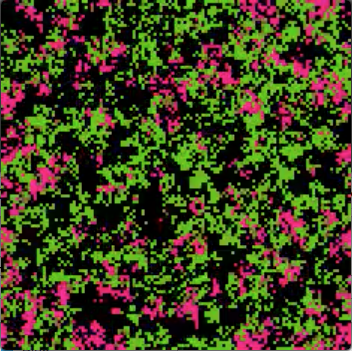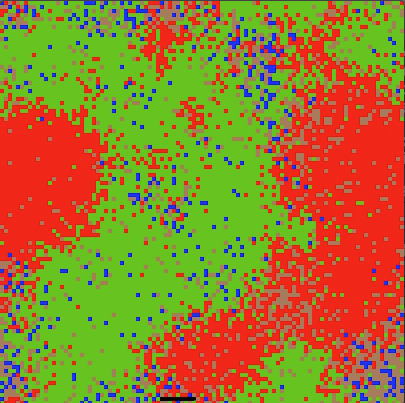EACH
The Evolution of Altruistic and Cooperative Behavior
Main Page, Curriculum Guide
Jump to Overview, Activities, Models, Papers, Researchers
Overview
The EACH project was founded at the Center for Connected Learning and Computer-Based Modeling at Tufts University. Our goal is to explore complexity in evolution through multi-agent modeling (aka object-based parallel or agent-based modeling). Our focus is the Evolution of Altruistic and Cooperative Behavior. EACH is an acronym for Evolution of Altruistic and Cooperative Habits. The EACH project is a curricular initiative under the auspices of two National Science Foundation Projects: Making Sense of Complex Phenomena through Building Object-Based Parallel Models and Participatory Simulations
We have developed a number of models in the StarLogoT modeling language that explore traditional evolutionary concepts such as "success" and "fitness" as emergent phenomena. Thus far, we have developed an "Altruism" model that demonstrates a plausible account of the evolutionary success of altruistic agents in competition with selfish conspecifics. We have also developed, in collaboration with students, a cooperation model that uses the notion of population viscosity to demonstrate conditions under which cooperative agents would have an evolutionary advantage over greedy agents.
Activities
Learning Environment
The EACH project emerged out of the larger scale MSCP project (located at Tufts University's Center for Connected Learning and Computer-Based Modeling (CCL). As part of the MSCP project, we study students at many different grade levels as they explore and create models of complex phenomena in the language StarLogoT. Students (from middle school to graduate school) come to the CCL and meet informally with project staff who mentor them in learning StarLogoT. Students explore models from the project library according to their interests. They are encouraged to vary and extend the underlying StarLogoT code for the project sample models and, when they feel ready, to create new models from "scratch". The topic of evolution, in general, is one that has appeals to many of the student modelers. For the high school students and many of the undergraduates as well, evolution was studied largely in "story" form. That is, they learned stories of how the theory of evolution came into being, how it was resisted and how it is supposed to work. Many of the students find these stories intriguing but unsatisfying. The dissatisfaction consisted of feeling that they did not have an adequate methodology for testing the plausibility of particular evolutionary arguments or for evaluating competing evolutionary claims.
Connected Learning
The EACH project is situated in a Connected Learning (1993; 1999) Framework . Connected Learning arises out of a constructionist (Papert 1980; 1991) paradigm that suggests that powerful learning arises from learners' construction of artifacts and external representations. Connected Learning suggests that a particularly valuable feature of learner constructions is the richness of the web of connections (Wilensky, 1991; 1993) constructed. The Connected Learning Framework was first instantiated in the Connected Mathematics (Wilensky, 1993), Connected Probability (Wilensky, 1995) and ConnectedScience (Wilensky & Reisman, 1999) projects. In the EACH project, we use a developmental sequence of activities and constructions that has been used successively in these projects. Students advance their participation in the EACH project through several stages. In the first stage, they view a projected StarLogoT model of evolutionary strategies and engage in discussion of the outputs of the model. In the second stage, they explore the model on their own, varying parameters of the model and recording the outputs. In the third stage, they open up the glass box of the model code and make a revision to the underlying premises of the model. In the final stage, they create their own conceptual models and code them from "scratch" in StarLogoT. The StarLogoT modeling language affords a natural diving in (Resnick & Wilensky, 1998; Wilensky, 1997a) to the complexity of the phenomena through identification with the individual elements ("agents") of the model. The sequence of stages scaffolds a contextualized model-based inquiry -- students pose questions arising from their interactions with models and then mutually refine the questions and models.
Models

Alutruism (Trait) Model
The altruism model models population genetics with respect to the fitness of traits that are affected by social and environmental conditions. The model has two breeds of patch agents: altruistic agents and selfish agents. The basic premise of the model is that the selfish agents and the altruistic agents are competing for each spot in the world by entering into a genetic lottery. You can imagine these agents as plants who "seed" for a spot, and the dominant seed generally wins. Under normal (non-interfering) environmental conditions (i.e., harshness and disease at low or zero values), the selfish agents win, and the altruistic population is driven to extinction. However, when the environmental conditions are made more harsh, the altruistic population is able to survive, and even dominate the selfish population.

Cooperation (Altruistic Behavior) Model
In this model, different breeds of cows compete for natural resources. Individuals that are more successful in getting the resources will reproduces more often, and will thus be more evolutionarily successful. There are two breeds of agents: greedy and cooperative cows. Every turn, each cow looks at the patch that it is currently on, and eats a unit of grass. The greedy cows eat the grass regardless of the length of the grass on the current patch. The cooperative cows won't eat the grass below a certain height. This behavior is significant because below a certain height (called the 'growth threshold') the grass grows at a far slower rate than above it. Thus, the cooperative agents leave more food for the overall population at a cost to their individual well-being, while the greedy agents eat the grass down to the nub, regardless of the effect on the overall population.
Divide-the-Cake Model

This is an evolutionary game-playing model based on William Harms's "Divide the Cake Model" from Brian Skyrms's "The Evolution of the Social Contract." In this model, there are three types of agents who must divide a common resource. Only two agents are permitted on any patch at any time. Each of the agent's tries to eat a certain amount of the patch's resources. There are one-half agents, one-third agents, and two-thirds agents, each of whom try to take the respective amount of the patch's resources. If the total amount requested by both agents is greater than 100%, then both agents die. Otherwise, each agent gets his requested share of the patch's resources. Each agent then enters a reproduction lottery based on its appetite: the greater appetite, the greater the chance of reproduction. This factor gives a fitness advantage to the agents with a greater appetite that counteracts the disadvantage of having a greater appetite (viz., the higher chance of asking for too much food and dying). Each turn, every patch resets to the full amount of food.
Papers
A Hands-on Modeling Approach to Evolution: Learning about the Evolution of Cooperation and Altruism Through Multi-Agent Modeling - The EACH Project, presented at ICLS 2000
Abstract: This paper presents a hands-on approach to learning about evolution; specifically, the evolution of altruistic and cooperative behavior. The classical view of individual selection stresses the importance of competition between individuals for resources and survival. On this view, altruistic and cooperative behavior appear to be disadvantageous for evolutionary success. However, looking at evolution as a complex system, altruism and cooperation can be seen as valuable traits for individual survival. The EACH project developed hands-on materials that enabled students to engage and test their intuitions about the fitness and evolutionary success of altruistic behavior. The primary materials consisted of a set of multi-agent models (written in StarLogoT) and associated activities that guided students in exploring evolutionary scenarios. Through their involvement in the EACH project, many students who had started with an understanding of evolutionary fitness as a trait of isolated individuals came to appreciate the complexity of environmental and social factors in the evolutionary process.
Survival of the Groupiest: Facilitating Students' Understanding of the Multiple Levels of Fitness through Multi-Agent Modeling - The EACH Project, presented at ICCS 2000
Abstract: This paper presents a hands-on approach to learning about complexity in evolution. Students are traditionally taught to think about evolution, and specifically fitness, in terms of the competition among same-species individuals for reproductive success. However, this understanding of fitness can promote misleading intuitions about how the evolutionary process works. An approach to teaching evolution that focuses solely on individual factors limits students' abilities to understand the complex ways in which environmental and social factors bear on the evolutionary success of individuals. In particular, the classical view of natural selection, as captured in the phrase "survival of the fittest", can obfuscate the possibility for understanding how altruistic and cooperative behavior can be advantageous for evolutionary success. In more recent work looking at evolution from a complex systems perspective, individual fitness can be seen as a multi-level phenomenon. By considering the interaction between individual, group, and environmental factors as constitutive of individual fitness, altruism and cooperation can be seen as valuable traits for individual survival. As part of the EACH project, we developed hands-on materials that are enabling students to engage and test their intuitions about the fitness and evolutionary success of altruistic behavior. The primary materials consist of a set of multi-agent models (written in StarLogoT) and associated activities that guide students in exploring the complexity of evolutionary scenarios. In one set of models, students explored the effects of environmental conditions, such as harshness and disease, on the formation of groups, and the success of altruistic behavior. In another set of models, co-developed by project researchers and a student learner, students explored the effects of population viscosity on the well being of cooperative populations. By experimenting with different levels of interaction between group formation, environmental conditions, and individual behaviors, students developed increasingly sophisticated conceptualizations of "fitness", and were able to extend project models and create new models for exploring complex evolutionary scenarios. Many students who had started with an understanding of evolutionary fitness as a trait of isolated individuals came to appreciate the complexity of environmental and social factors in the evolutionary process.
Researchers
Principal Investigator - Uri Wilensky
Lead Researcher - Damon Centola
Researcher - Eamon Mckenzie
Consultants - Joshua Mitteldorf (University of Pennsylvania) and Daniel Dennett (Tufts University)
Acknowledgements
The EACH project gratefully acknowledges the support of the National Science Foundation (AAT and REPP programs), and is supported under NSF grant numbers REC-9632612 and REC-9814682. Work on the project originally began under the title CONNECTED MATHEMATICS: MAKING SENSE OF COMPLEX PHENOMENON THROUGH BUILDING COMPUTATIONAL MODELS.